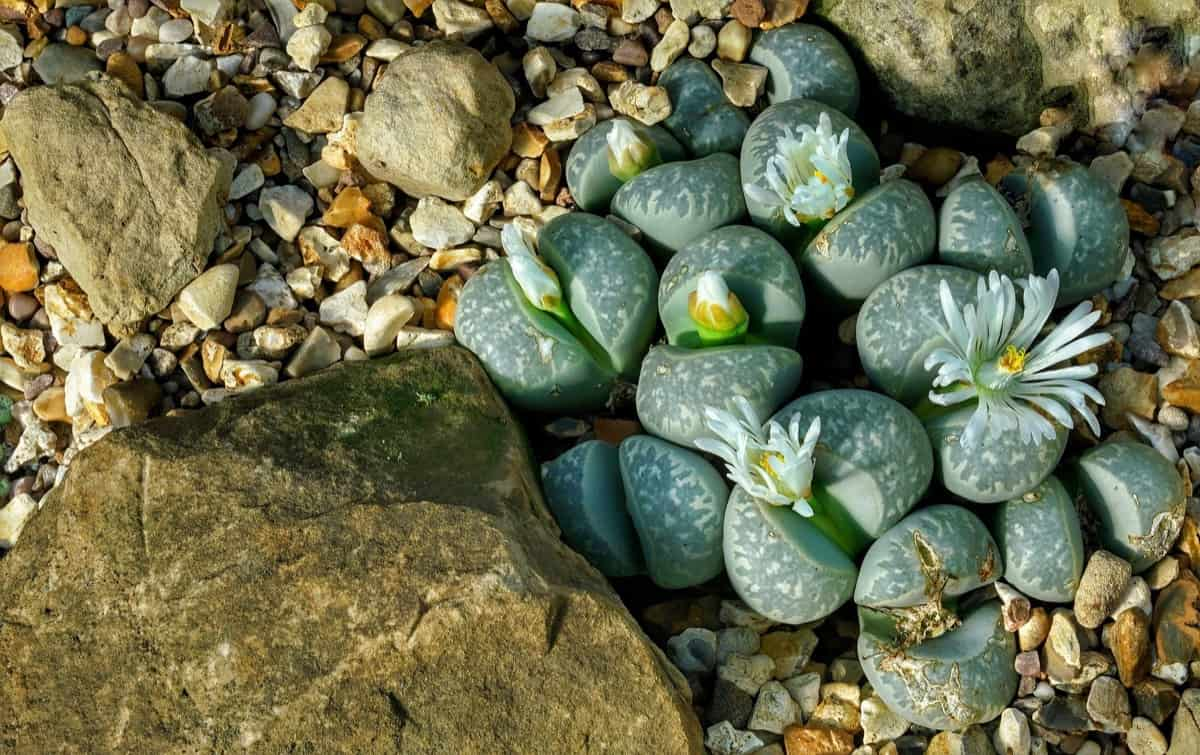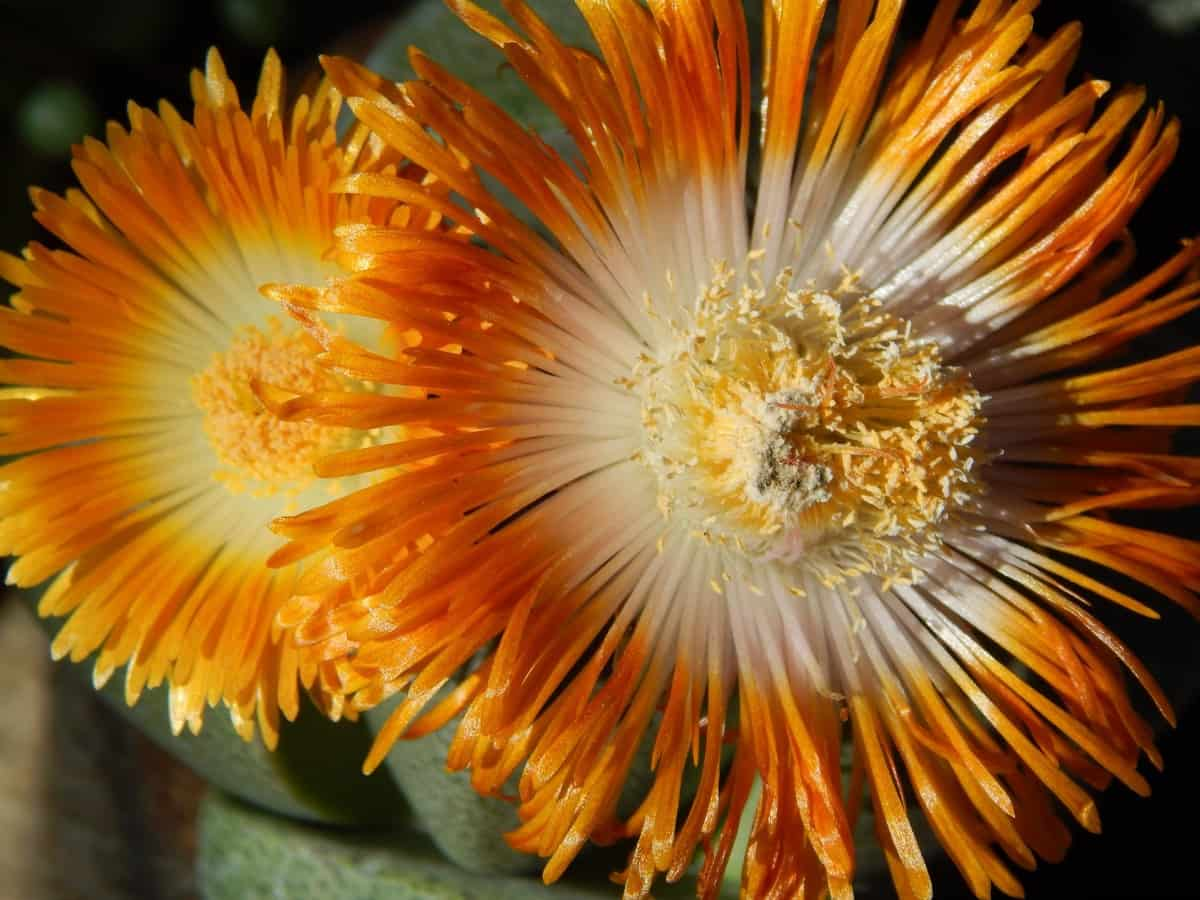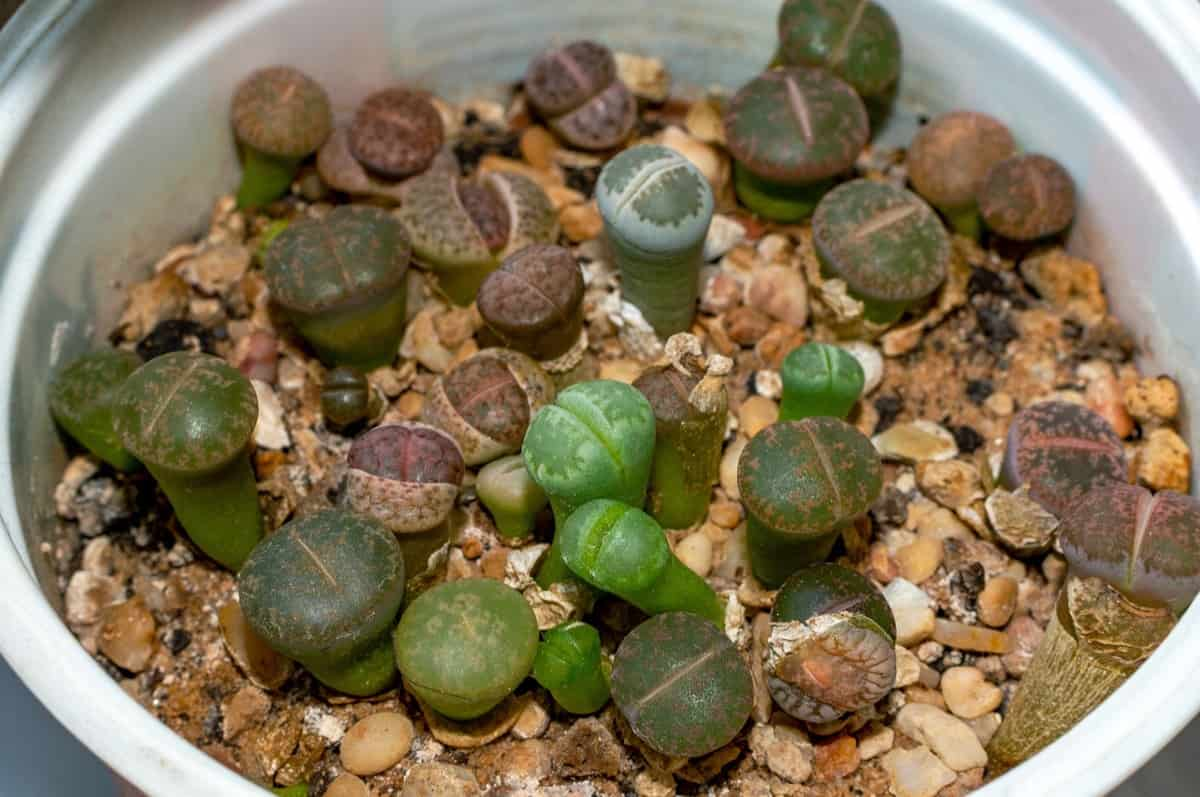Living stones are a type of succulent that gets its name from its stone-like appearance. Living stones are slow-growing and can live for many years with little care. With patience and the proper care, you can grow these fascinating plants in your home. These plants are perfect for people who want an attractive, low-maintenance plant. Living stones are available in various colors, including green, gray, brown, and pink.

Some varieties even have stripes or patterns on their leaves. Consider growing Living stones if you live in a hot, dry climate and are looking for a low-maintenance plant to add to your collection. There are many reasons to consider growing Living stones. For one, they are very low maintenance all they need is a little water and some sunlight. They are also very tolerant of heat and drought, making them ideal for dry climates. Also, Living stones are unique-looking plants that will interest any garden.
How to grow and care for Living Stones/Lithops
Types of Living stones
- Lithops localis – The plant leaves are thick and fleshy and grow close to the ground. Lithops localis is drought-tolerant and can store water in its leaves for long periods. The plant flowers are in the summer, and the flowers are typically white or yellow.
- Lithops hookeri – It is a small, succulent plant that grows like a rosette. This plant’s leaves are green with white or light-colored stripes running down the center. The flowers of Lithops hookeri are white or pale pink in color and bloom in the fall or winter.
- Lithops Salicola – It is a small, succulent plant that typically grows to only about 2-3 inches in height. The leaves of this plant are thick and fleshy, and they are arranged in pairs. The leaf margins are often serrated or scalloped, and the leaves are green with white or pale green markings.
- Lithops Optica – These have fleshy, green leaves arranged in pairs and shaped like disks or triangles. The leaves are often marked with white, brown, or red patterns that help the plant camouflage itself in its natural habitat. Lithops Optica typically blooms in the late summer or early fall, producing small, white, or yellow flowers.
- Lithops Aucampiae –The plant has thick, fleshy green leaves with white or yellow flowers that bloom in the fall.
- Lithops julii – Lithops julii typically grows to a height of 2-3 centimeters and has green or grey-green leaves with white or pale yellow markings. The flowers of this species are white or pale pink and appear in late summer or early fall.
- Lithops Werneri – The plants are small, with fleshy green leaves with brown or black markings. The flowers are white or yellow and bloom in the summer.
In case you missed it: How to Grow and Care for Rhododendrons: A Beginners Guide

Climate suitable for growing Living stones
Lithops are small, succulent plants that resemble stones or pebbles. They can be found in various colors, patterns, and shapes. While Lithops are typically easy to care for, they have some specific requirements regarding climate. To thrive, Lithops need full sun and well-drained soil. They also prefer a warm climate; if temperatures dip below 10°C, Lithops will experience stress and may even die. Lithops require very little water and can thrive in hot, dry climates with little to no supplemental irrigation.
When choosing a location to grow your Lithops, select an area with full sun and well-drained soil. You can even plant Lithops outdoors if you live in a warm climate. If you live in an area with cool winters, you can grow Lithops indoors on a sunny windowsill. Just make sure to provide them with plenty of light and ventilation to prevent rot. With proper care, your Lithops should thrive and produce beautiful flowers in the late summer or early fall.
Soil requirement for growing Living stones
Lithops need very little soil to survive and grow. They do best in a sandy, well-drained mix. You can add sand or grit to improve drainage if your soil is heavy or clay-like. You can also grow Lithops in pure sand. When planting Lithops, be sure to plant them shallowly. They don’t have a deep root system, so they don’t need much space. Just press them gently into the soil so that they’re barely covered. You also want to ensure the soil is not too dense, as this can cause problems with drainage.
Water requirement for growing Living stones
Watering is also essential for Lithops care. These plants are native to arid regions, so they’re used to Living with limited water. During the growing season (spring and summer), water your Lithops once a week, letting the soil dry out completely between waterings. When watering, use a light hand as too much water can rot the roots. Water only when the soil is dry to the touch. Lithops should generally be watered about once a week during the growing season and every other week during the winter.
The quantity of water Lithops needs greatly depends on the time of year and its growing climate. In general, during the summer months, when they are actively growing, they will need more water than during the winter when they are dormant. When watering Lithops, it is essential not to over-water them.
This can cause them to rot and die. Watering them deeply but infrequently is best, allowing the soil to dry between waterings. Lithops may need to be watered during the active growth period every week or two. In cooler weather or when they are dormant, they may only need to be watered every month or so.
In case you missed it: How to Grow and Care for Ageratum Plant: A Beginners Guide

Living stones propagation
From seed
Lithops are relatively easy to propagate from seed, often the best way to obtain new plants. You should sow Living stones seeds on the surface of a well-drained potting mix and then cover it with a thin layer of sand or grit. The pot should be placed in a warm, sunny location and maintained at a temperature between 21 to 26°C.
Once germination occurs (which can take 1-2 weeks), the young Lithops must be transplanted into individual pots. Be sure to handle the delicate plants carefully, as they are easily damaged. After transplanting, water sparingly for the first few weeks until the Lithops have become established in their new pots.
From divisions
To propagate Lithops from divisions, remove a piece of the plant with a sharp knife or garden tool. Be sure to include some of the stem tissue in your division. Before planting them in well-drained soil, allow the cuttings to be callous for a few days. Once planted, water your Lithops sparingly, only enough to keep the soil moist. Provide bright light, but avoid direct sun exposure, which can scorch the leaves. With proper care, your Lithops should begin to grow and form new plants within a few weeks.
Living stones care
Fertilizer requirement for growing Living stones
Lithops are unique-looking succulents adapted to survive in hot, dry climates. If you’re thinking about growing Lithops, you’ll need to use the right fertilizer to help them thrive. Look for a fertilizer that’s specifically designed for cacti and succulents. This will ensure that it has the right balance of nutrients for plants like Lithops. Avoid using a fertilizer with too much nitrogen. Lithops are slow-growing plants, so they don’t need much of this nutrient.
The best fertilizer for Lithops is high in phosphorus and potassium and low in nitrogen. A good ratio to look for is 5-10-10 (phosphorus-potassium-nitrogen). This will help encourage strong root growth and blooming. Be sure to choose an organic fertilizer if possible, as chemicals can harm these delicate plants. When applying fertilizer, be careful not to overdo it. A light sprinkling around the base of the plant is all that’s needed. Once a month is usually sufficient, although more frequent feedings may be necessary for very hot weather.
In case you missed it: How to Grow and Care for Baby Toes Succulent: A Beginners Guide

Pruning Living stones
Pruning Living stones is crucial to keeping your Lithops healthy and looking their best. When you first get your Lithops, they will likely need very little pruning. However, they will need to be pruned more frequently as they grow and mature. Make cuts at a 45-degree angle just above a node (the point where leaves and stems intersect). This will help new growth to emerge more easily. Be careful not to damage the plant’s delicate roots when pruning. With proper care, your Lithops will continue to grow and thrive for many years.
The best time to prune Lithops is in the spring after they have finished blooming. Cut away dead or dying leaves using sharp, clean scissors or a knife. You can also trim away any leaves significantly longer or wider than the others. Be careful not to damage the growing point (the center of the plant where new leaves emerge). If you accidentally damage the growing point, your plant may not produce new leaves for several months. After you have finished pruning, water your Lithops well and place them back in their spot in bright, indirect light.
Living stones care in winter
When the temperature starts to drop, Living stones care must be taken to ensure that these delicate succulents don’t succumb to the cold. If you live in an area where the temperature gets too cold for Living stones to survive, it’s best to bring them indoors. Please place them in a bright spot near a window and make sure they have well-draining soil. Let the soil dry completely before watering again. Protecting your Living stones is essential if you live in an area with a frost risk. Please place them in a sheltered spot away from any cold drafts. You can also cover them with a light cloth or sheet if necessary.
In case you missed it: How to Grow Lipstick Plants Indoors: A Beginners Guide

Repotting Living stones
Choose a pot slightly larger than the current pot to repot a Living stone. Remove the plant and shake off any excess soil. Gently place the Living stones plant in the new pot and add fresh cactus mix or well-draining potting soil. Water the plant thoroughly, then place it in a warm, bright spot.
Pests and diseases of Living stones and their control
- Lithops are relatively easy to grow and care for but can be susceptible to pests and diseases. One of the most common problems with Lithops is mealybugs. Mealybugs are small, white, fuzzy insects that feed on the sap of plants. Spider mites cause discoloration and stippling of leaves and kill the plant if left unchecked.
- Fungus gnats are small black flies that breed in damp soil. They don’t damage the plants directly, but their larvae can eat the roots, stunting their growth. These can be controlled by spraying the plant with neem oil solution.
- Pythium root rot is caused by a water mold that attacks the roots of plants. It can cause them to turn yellow and wilt, eventually killing the plant. Another common problem is scale insects. Scale insects are small, hard-bodied pests that suck the sap out of plants. They can cause the yellowing of leaves and stunted growth. Scale insects can be controlled by spraying the plant with an insecticidal soap or neem oil solution.
- Finally, root rot is one of the most severe problems affecting Lithops. Root rot is caused by fungi that attack plants’ roots and prevent them from properly taking up water and nutrients. You can control it by adopting a proper watering schedule.
In case you missed it: How to Grow Zinnias from Seed: A Guide to Planting to Harvesting for Beginners

Conclusion
Living stones are a type of plant that is well suited to growing in dry, hot climates. They have many adaptations that allow them to survive in these conditions, such as thick, fleshy leaves that store water and prevent evaporation and a deep root system that can access underground water sources. If you live in an arid climate and are looking for a low-maintenance plant to add to your landscape, consider one of the wide varieties of Living stones. You can enjoy these attractive plants in your home or garden for many years with just a little care.
- How to Grow Tomatoes Organically at Home: A Comprehensive Guide
- Organic Gardening on a Budget: Low-Cost Methods and Materials
- Gongura Seed Germination and Planting Methods
- Cabbage Seed Germination and Selection
- Broccoli Seed Germination and Selection
- Asparagus Seed Germination and Variety Selection
- Seasonal Flower Gardening: Best Practices for Spring, Summer, Fall, and Winter
- How to Grow Hibiscus from Flower
- Plantation Ideas for Home Decoration: A Beginners Guide
- Flower Garden Designs and Layouts for Beginners
- Planting and Spacing Techniques in Papaya: A Beginner’s Guide
- Growing Gold: Essential Techniques for Planting Pineapples
- How to Make Kalanchoe Plant Bushy: Home Remedies and Solutions
- 11 Reasons Why Your Gardenia is Not Blooming: Home Remedies and Solutions
- Eco Elegance: The Guide to Designing a Drought-Tolerant Landscape
- Gardening on a Slope: Strategies for Hillside Landscaping
- Nourish and Flourish: Top Organic Mulches for Thriving House Plants
- Everything You Want to Know about Indian Mogra Flower: Discover Uses and Growing
- Green Thumb Success: Expert Tips for Cultivating Greenhouse Pumpkins All Year Round
- Maximize Growth & Flavor: The Ultimate Guide to Companion Planting in Herb Gardens
- How to Control Rhododendron Problems Naturally: Home Remedies and Organic Ways to Fix Them
- Natural Magic: The Remarkable Benefits of Cinnamon for Plants
- Best Steps to Revive Dying Tulip with Natural and Organic Treatment
- 10 Reasons Why Your Angel Trumpet is Not Blooming: Remedies and Treatment
- How to Fix Periwinkle Leaf and Flower-Related Problems: Natural Remedies and Solutions
- How to Fix Zinnias Leaf and Flower Problems: Discover Natural and Home Remedies
- Organic Steps to Induce Lemon Tree Flowers: A Comprehensive Guide
- Bloom Booster: Crafting the Perfect Homemade Bougainvillea Fertilizer
- Optimizing Growth: A Guide to Applying NPK Fertilizer for Potted Plants
- 10 Best Homemade Fertilizers for Rubber Plant: DIY Recipes and Application Method
- How to Boost Female Pumpkin Flowers: Effective Steps for More Flowers and High Yields
- Transform Your Indoor Garden: Top Benefits of Pink Salt for Houseplants
- 10 Best Homemade Fertilizers for Peacock Plants (Calathea): Easy DIY Guide
- Unlock Blooms: 9 Reasons Why Your Potted Chrysanthemum is Not Blooming
- 8 Reasons Why Your Potted Hibiscus is Not Blooming: Fix it with Simple Solutions
- Unlock Blooms: 9 Key Reasons Your Potted Frangipani Won’t Flower